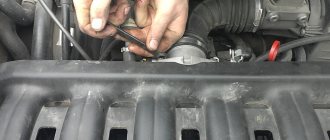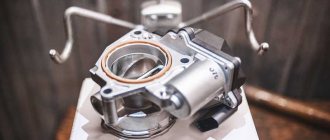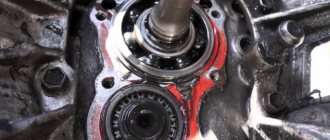The normal functioning of a car's intake manifold requires a certain geometric value. The parameters must correspond to the specified frequency of each crankshaft rotation. Standard design features contribute to optimal cylinder filling only when engine speed is limited and within a specific range. Therefore, to ensure that a sufficient volume of air flow enters the combustion chamber, a system is used to change the geometry of the intake manifold.
This technology is gaining popularity due to providing the engine with an increased level of power, saving fuel, and reducing exhaust toxicity.
How the collector works when the geometry changes
In practice, the intake manifold can be transformed by changing the cross-sectional area and also by changing the length. Such methods are quite applicable both separately and in tandem.
If we consider the choice of method for changing the size of the intake manifold, then it is more suitable for vehicles equipped with engines that operate equally with fuel and diesel. The exception is supercharged systems.
The essence of this design is the following features. If the engine load is low, the air flows along a long path. Accordingly, at high speeds there is a short distance.
The operating mode of the engine ECU changes through an actuator that switches the valve between points of the manifold. The operating principle of the variable intake element is based on achieving the result of resonant charging. In this way, air is intensively pumped directly into the combustion chamber.
The manifold then retains some of the air mass if all the intake valves are closed. Oscillations of these air residues appear in the pipeline. The actions are proportional to the engine speed and the length of the intake manifold.
When resonance oscillations are reached, the pressure becomes high. When the valve opens, discharge will be observed. In the case of supercharged engines, this technology is not applicable. This is due to the lack of need to achieve resonant boost. In such systems, air is forced into the air using a turbocharger.
Shape and volumetric efficiency
One of the most important parameters of the intake manifold that determines its efficiency is its shape. The basic rule that all engineers adhere to is that the intake manifold should not have any angular shapes, as this will provoke pressure drops and, as a result, worse filling of the cylinders with air or working mixture. Therefore, all collectors have smooth transitions between segments and rounded shapes.
The vast majority of current collectors use runners. They are separate pipes diverging from the central entrance of the manifold to all available intake channels in the cylinder head. Their task is to use a phenomenon called Helmholtz resonance. The operating principle of the design is as follows.
At the moment when suction occurs, air flows at a very high speed through the open inlet valve. When the valve closes, the air that did not have time to enter the cylinder retains a large impulse, which means it presses on the valve, resulting in a high-pressure zone. Then pressure equalization occurs, with lower pressure in the manifold.
Due to the influence of inertial forces, leveling occurs with fluctuations: first, air enters the runner at a pressure lower than in the manifold, then at a higher one. This process occurs at the speed of sound, and before the intake valve opens again, oscillations can occur many times.
The smaller the diameter of the runner, the greater the change in pressure due to resonant air vibrations. As the piston moves down, the pressure at the outlet of the runner decreases. This low pressure pulse then travels to the manifold inlet where it turns into a high pressure pulse that travels in the opposite direction through the runner and valve, after which the valve closes.
To achieve the maximum effect from resonance, the intake valve must open at a strictly defined moment, otherwise the result will be the opposite. This is quite difficult to achieve. The gas distribution mechanism is a dynamic unit, and its operating mode is directly dependent on the crankshaft speed.
The pulses are synchronized statically, the synchronization depends on the length of the runners. The problem is partially solved by selecting the length for a certain speed range at which the greatest torque is achieved. Another option is the use of systems for changing the geometry of the intake manifold and electronic timing control.
Variable cross-section of the intake manifold
This type of geometry change is used by automakers of cars with different engine systems. Depending on the cross-section of the pipeline, the flow rate may decrease or increase. If it has a smaller cut, the speed will be greater. This design is equipped with separate cylinders having two inlet ports. Each has its own intake valves.
The channel pair has a damper. The system for changing the geometry of the intake manifold in this case is carried out under the influence of an electric motor, and can also come from a vacuum regulator.
The operation is based on the principle that the power unit operates at low speeds when the dampers are closed. Opening the intake valve ensures that the air-fuel mixture enters the cylinder through only one channel. This air supply through one channel reaches the chamber in a spiral. This allows for better mixing with fuel. Operating the engine at high speeds, with the dampers closed, ensures the passage of air flow through two channels. As a result, the engine power increases several times.
Manifold tuning
Engine tuning is a whole range of work to refine its individual components and parts. The intake manifold can also be modified to improve engine performance.
Tuning this part has two directions:
- to overcome the negative influence of its form;
- for finishing the internal surface.
What does form have to do with it?
The flow of air or working mixture in the manifold is uneven due to its shape. If the manifold is asymmetrical, then the largest amount of air or fuel-air mixture will enter the first cylinder, and less will enter each subsequent one. The symmetrical one also has a drawback: there, the largest amount of air enters the middle cylinders. In both cases, the cylinders operate unevenly on mixtures of different qualities. As a result, engine power decreases.
Tuning, in this case, involves replacing the standard intake manifold with a multi-throttle intake system. Its design is such that the air flows supplied to the cylinders are independent of each other, since each of the cylinders is equipped with its own throttle valve.
"Internal" work
If there is a lack of funds, tuning can be done more cheaply, almost for nothing. Inside the reservoirs there are almost always a large number of irregularities and tides, and the surface is rough. All together, this causes unnecessary turbulence that interferes with the quality filling of the cylinders. During measured driving, this phenomenon is almost unnoticeable, but if you want to achieve greater efficiency from the engine, you need to fight these shortcomings.
Tuning a standard intake manifold involves grinding its inner surface in order to remove tides and roughness. You need to grind not until a mirror appears, but only until the entire surface is uniform. If you overdo it, drops of fuel will condense on the walls and tuning will give a completely opposite result.
Finally, in order for the tuning to be as complete as possible, you need to pay attention to the interface between the manifold and the cylinder head. Often, a step remains in this place, interfering with the normal flow of air flow, which must be eliminated (this is where cylinder head tuning begins).
What else is worth reading
Clutch housing
The principle of operation of an injection engine
How can you burn the clutch on a car?
Gas distribution mechanism
Is technology necessary?
The sequential formation of the intake tract, which is created by the throttle, filter, and valves, has a strong influence on the process of filling the cylinders with fuel. The air mixture that passes through this path fluctuates significantly. Together with other parts they form a shock system. This leads to the dependence of the processes of filling the cylinders on the factors of the oscillatory configuration.
Obtaining the efficiency of the system with the required parameters and the required range seems to be an extremely complex procedure. As a consequence, there is the idea of changing the performance of the oscillatory system during operation. After conducting research, it can be stated that the engine works well at high speeds with a short intake manifold. The opposite is true at low revs; efficiency can be achieved with a long intake tract.
It is logical that the conclusion arises to create an intake tract of variable length. This will allow them to be controlled taking into account different loads and speeds.
Basic faults
Like any device, the intake manifold can fail. The cause of the breakdown can be either banal wear of certain parts or other external factors.
Read more: What to do in case of an accident and how to behave when registering an accident
Depressurization. Violation of the integrity of the housing most often occurs due to wear of the sealing gaskets. In this case, additional air pumping into the collector occurs - suction. This is not as good as it might seem: the engine is designed to receive a strictly defined amount of air in its operating mode.
Deposits: In engines with central injection or carburetor, impurities from the fuel may settle on the internal walls. But the problem of build-up in the intake manifold is much greater in systems with exhaust gas recirculation. Plaque on the inside disrupts the geometry of the intake manifold, the air flow passes with less turbulence, and its mixing with fuel is worse. A clogged collector can be cleared by cleaning.
Damage to the dampers. If the dampers in the intake manifold are made of poor quality material, they may fail. Many German car models suffer from this “disease”.
In addition to the poor quality of the valves themselves, the cause of the malfunction can be oil getting into the manifold space. In this case, you will have to look for the cause of oil consumption and eliminate it, and only then repair the valves.
Sensor malfunction. Temperature and pressure sensors may fail, resulting in incorrect data being sent to the ECU. Sometimes a failure in the system is so significant that the control unit switches the engine to emergency mode. The sensors are checked at a service station, and if necessary, they are replaced with new ones.
From the theory of gas exchange in internal combustion engines
From the operating principle of a 4-stroke engine, we know that when the piston moves to BDC and the intake valve is open, air from the intake manifold is directed into the cylinder.
If we take the free volume of the combustion chamber, which can be filled with air, as 1, then in practice, due to various types of losses, the cylinder filling factor of an atmospheric engine is 0.7-0.8 (for turbocharged engines this parameter is higher and depends on the performance of the supercharger) . The problem of supplying the engine with air is one of the main ones in the process of creating an engine, since the performance of modern injectors allows huge doses of fuel to be poured into the cylinders. But this fuel will burn ineffectively or will not ignite at all if there is not a sufficient amount of oxidizer, that is, air, in the combustion chamber.
The concept of resonant boost
A significant influence on the volume of air that is able to enter the cylinder during the intake stroke depends on the flow area of the intake duct and the volume of the receiver. It is the optimization of air flow that is the main purpose of the variable intake geometry.
But what exactly is the operating principle based on? Since air has mass, it gains kinetic energy as it moves during the intake stroke. At the moment the intake valve closes, the air remaining in the manifold is directed by inertia to the blocked channel, hits the wall and resonates, returning to the throttle assembly. The throttle valve elements, receiver design and pipes also create resistance to the air flow, which forces it to return again in the direction of the valve. If at this moment you open the intake valve, then during the intake stroke the maximum amount of air possible at this operating point of the engine will enter the cylinder. This phenomenon is called resonant supercharging. This is partly why the geometry of each engine determines a specific speed range at which cylinder filling is most optimal.
The advantage of variable geometry
The frequency of oscillations of air flows primarily depends on the number of engine revolutions, but also on the length and cross-section of the intake manifold channels. This is explained by the fact that at low speeds the piston speed is lower, therefore, the resonating frequency of air flows decreases. The narrower the channel, the greater the speed of the moving air flow. For better filling of the cylinders, a narrow and long channel should be at low engine speeds. Whereas at high speeds, a small channel cross-section will create strong pumping losses, because at peak loads the engine consumes much more air than at low speeds.
The introduction of variable intake manifold geometry has 2 goals:
- the ability to adjust the resonance of air flows to engine speed;
- regulate the speed of flow and the mass of incoming air. Passing through a narrower channel, the flow gains much greater speed. This increases turbulence in the cylinder and improves mixing of the fuel-air mixture, which is important for complete combustion of fuel. A channel of shorter length and larger cross-section allows the engine to be fully supplied with air at high speeds.
About tuning instead of an epilogue
When thinking about the exhaust manifold, one cannot ignore the topic of tuning, because this part quite often ends up on the list of those subject to modification.
As a rule, on the market you can find different configurations of this element for a specific model.
Exhaust manifolds allow you to achieve, for example, good performance at low speeds or in the mid-range - for every taste and color.
And in motorsports, they often do away with exhaust manifolds altogether, connecting the exhaust pipes directly to each cylinder.











